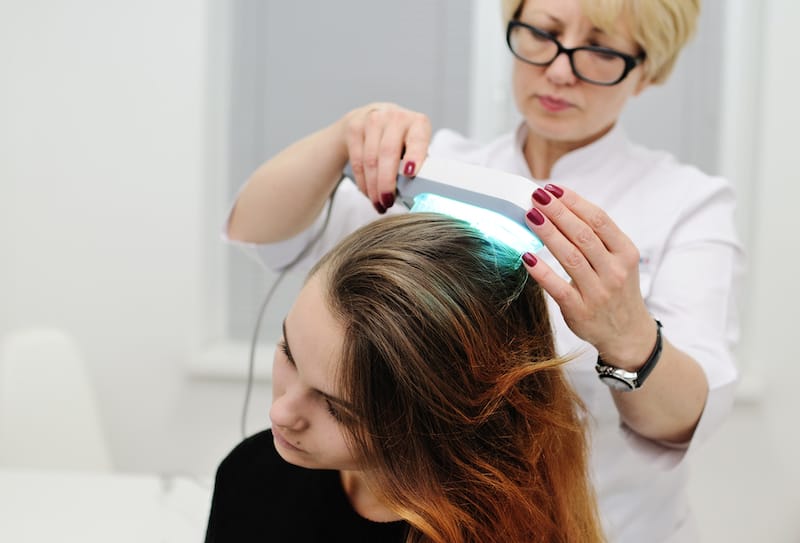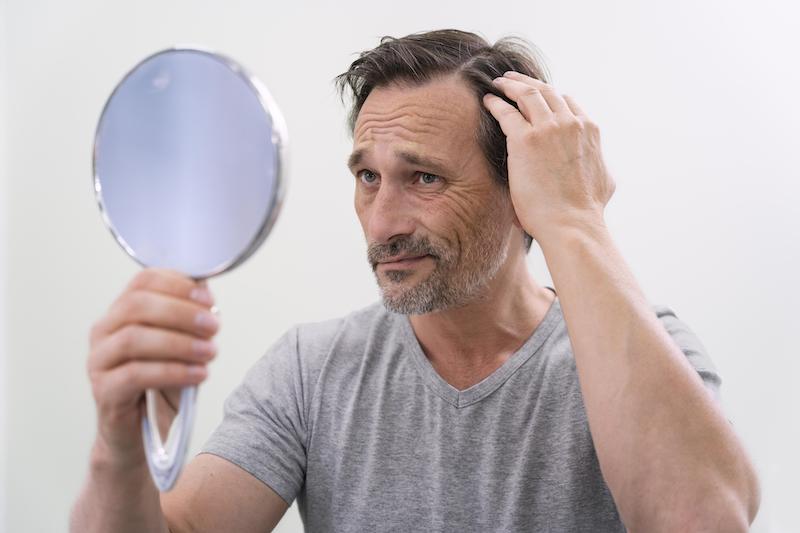Head shingles caused by the varicella-zoster virus are the most sensitive type of shingles and need careful handling. If not treated carefully, it can affect the follicles and leave you with bald spots or permanent hair loss. Since the scalp is so sensitive, you need to be careful when combing or shampooing it. Avoid dyeing your hair because the harsh chemicals can lead to a severe allergic reaction. Only after treating it with antiviral medications and making sure the rash and other physical symptoms are gone, which would take approximately five weeks, can you start using the dye. Consult your doctor before starting using the hair dye.
Shingles, popularly known as herpes zoster, is a nasty skin infection caused by the Varicella-zoster virus.
And according to the Centers for Disease Control and Prevention (CDC), 1 out of 3 Americans are sure to develop shingles in their lifetime.
Although it’s rare to get shingles more than once, it ultimately depends on how you take care of your scalp.
People become curious about how to go about dyeing one’s hair when affected by shingles. Is it something that will worsen their scalp condition?
Or are there ways around it that can help you still maintain your hair the way you want them to be?
And lastly, can hair dye be the possible cause behind developing shingles? Let’s take a look!
Harsh symptoms of shingles on scalp
To make sure if you’re suffering from shingles or not, one must look at the list of symptoms, and there are many.
It’s like a painful rash that can be anywhere on the body, such as your face, arms, bottom, and even scalp.
On the scalp, it becomes even more challenging to manage.
But you can manage to start the treatment if you pay attention to the initial symptoms of shingles, which include:
- Burning
- Sharp pain
- Tingling
- Numbness in skin
- Severe itching or aching
- Fatigue
- Fever
After the initial period, a rash of blisters and reddened skin will develop on the scalp.
You’ll notice a headache forming and weakness of one side of the face if the shingles rash occurs around the ears.
This can make everyday tasks such as combing impossible because you risk bleeding and aggravating your present condition.
With the blisters on the scalp, it becomes almost impossible to think about grooming the hair, including applying hair dye.
Causes of shingles on scalp
Shingles are caused by the same virus that causes chickenpox known as the varicella-zoster virus.

If you’re currently suffering from shingles, chances are you recovered from chickenpox earlier, and the virus then remains dormant in the body and revives if triggered somehow.
But there’re additional risk factors such as:
- An illness that weakens your immunity
- Undergoing cancer treatment
- Taking certain medications
- Prolonged stress or infection
Shingles on scalp
Your scalp can be quite sensitive during this time, and even the slightest pressure can worsen things.
It’s challenging also as, on the one hand, your head is itchy because of the shingles rash; it’s also challenging to stop the urge to itch.
The combing or scratching needs to be avoided as it can also lead to hair loss through a condition known as cicatricial alopecia.
Scarring caused by the shingles rash destroys stem cells in hair follicles that create new hair growth, and it can lead to permanent hair loss as the follicles are so damaged.
Shingle and hair dye
With such a bad condition of the scalp, if you want to consider dyeing your hair, it can turn out to be a horrible decision.
Hair coloring products contain many ingredients that are bad for your scalp.
People out there get allergic to hair dye even if they aren’t suffering from shingles, and it can irritate your scalp, and with shingles, your current condition can even worsen.
Your hair follicles are deeply affected by the symptoms of shingles, and on top, if you use hair dye, it can quickly destroy the follicles leading to permanent hair loss.
Some people might even confuse hair dye allergy or sensitivity with shingles because the symptoms can be pretty similar.
Like shingles, the rash can be confused with the inflammation from an allergic reaction caused by hair dye.
A sensitivity from hair dye can cause contact dermatitis symptoms, such as burning and stinging or red, dry skin.
The allergy symptoms can be described as:
- Stinging or burning sensation on scalp, face, or neck
- Blisters or welts
- Itching or swelling of the scalp and face
- Swollen eyelids, lips, hands, or feet
- An angry, red rash anywhere on the body
PPD is a chemical that is part of the hair dye and is most prominent in causing an allergic reaction. But other ingredients such as ammonia, resorcinol, and peroxide can cause allergic reactions too.
On a scalp suffering from shingles applying hair dye can wreak havoc.
Treating a scalp with shingles
Of course, starting with prescribed medications is needed to help heal your scalp faster.
This would include antiviral drugs as soon as you notice the symptoms for faster healing. One suffers unbearable pain, so pain medication will also be prescribed.
Aside from the medications, there are other ways to deal with the problematic shingles scalp.
These are mostly tips and tricks one can do at home with ease to help the scalp heal faster and not worsen the present condition:
- Use cool water and cold compress on the scalp to help soothe the pain and rash. It helps with the burning sensation too.
- Lotions such as calamine or menthol can give that cooling effect and keep the affected part cooler for longer.
- Even though you should avoid shampooing your hair for 3-4 days, use gentle round motions to cleanse your scalp. Make sure you don’t scrub, and your nails are clipped.
- Use only lukewarm or cold water and never hot water.
- When trying to dry your hair, let it air dry and only use a towel to dab the excess water away slowly.
- Don’t use styling products such as maks, mousse, or sprays.
- When combing your hair, make sure the brush has very soft bristles that wouldn’t harm the scalp.
FAQs
How long does it take shingles in the scalp to go away?
The rash from shingles might take up to 1 to 3 weeks to heal.
At the same time, the pain and irritation may linger for longer and stay for about 3 to 5 weeks.
It might heal faster if you started taking care of it in the initial period, and the blisters won’t leave scarring.
Can shingles cause sharp pains in the head?
Shingles can cause pain in the head, and sometimes it can be mild and tolerable, but other times quite a stabbing pain.
This is the reason why a doctor might also recommend taking pain medications.
The affected area will always be tender and would need careful consideration whenever washing, drying, or combing it.
The sharp pain might also lead to severe headaches if proper treatment isn’t started within time.
Can shingles make you tired?
Experiencing extreme fatigue is a symptom of suffering from shingles and is common in patients.
Even after you are on the road to healing, you might experience pain for a long time afterward, which can also cause fatigue.
This lingering pain is a phenomenon known as PHN postherpetic neuralgia. This can cause long-term pain, which might last for days, weeks, and even years.
Can you get shingles on your neck and head?
There’s a possibility of getting the area nearby affected with shingles too.
If you get it on your scalp, you can get it on your neck, and even other parts like the torso, waist, chest, or back will erupt with rashes.
But the good thing about this infection is that it only spreads to one side of the body and keeps it there. So if the left side is affected, only the left side will have the rashes.
And shingles on the scalp are significantly trickier to treat and require careful observation and consideration.
Can shingles affect the brain?
Depending on which nerves are affected, shingles can cause an inflammation of the brain (encephalitis), facial paralysis, or hearing or balance problems.
These are neurological issues but can be described as rare and severe symptoms.
This only happens when the treatment can’t be started within time and shingles spread far enough to affect the brain in various ways.
To summarize
Shingles on the scalp are just one way of appearing on the body caused by the varicella-zoster virus, and it can indeed affect more parts of the body and become nasty in no matter of time.
This viral infection is most difficult to treat on the scalp because it directly affects your grooming of the scalp.
Even using a comb can become a task, and shampooing must be done carefully.
Under such circumstances, dyeing your hair is almost impossible, for your scalp is in no condition to handle all these chemicals.
If the scalp isn’t treated within time, it can lead to severe headaches and permanent hair loss.
Lay off on dyeing your hair until the rash disappears. Only after there’re no physical symptoms can you start using dye in hair after discussing it with your doctor!


